Hetero-Epitaxial Growth of AlN Deposited by DC Magnetron Sputtering on Si(111) Using a AlN Buffer Layer
Abstract
:1. Introduction
2. Materials and Methods
- is the stress on GPa.
- E is the Young’s module of the substrate in GPa.
- is the Poisson’s ration for the silicon substrate.
- ts is the silicon thickness in m.
- tf is the film thickness in m.
- rc the radius of curvature of the substrates before AlN deposition in m.
- ru are the radius of curvature of the substrates after AlN deposition in m.
3. Results and Discussion
4. Conclusions
Author Contributions
Funding
Institutional Review Board Statement
Informed Consent Statement
Data Availability Statement
Acknowledgments
Conflicts of Interest
References
- Xiong, J.; Guo, P.; Guo, F.; Sun, X.; Gu, H. Room temperature ferromagnetism in Mg-doped AlN semiconductor films. Mater. Lett. 2014, 117, 276–278. [Google Scholar] [CrossRef]
- Aubry, R.; Michel, N.; Jacquet, J.C.; Baczkowski, L.; Patard, O.; Chartier, E.; Semmar, N. S3-P11: Thin-film coatings for improved thermal performances of GaN-based HEMTs. In 2014 Lester Eastman Conference on High Performance Devices (LEC); IEEE: Providence, RI, USA, 2014. [Google Scholar] [CrossRef]
- Rodríguez-Madrid, J.G.; Iriarte, G.F.; Araujo, D.; Villar, M.P.; Williams, O.A.; Müller-Sebert, W.; Calle, F. Optimization of AlN thin layers on diamond substrates for high frequency SAW resonators. Mater. Lett. 2012, 66, 339–342. [Google Scholar] [CrossRef] [Green Version]
- Clement, M.; Vergara, L.; Sangrador, J.; Iborra, E.; Sanz-Hervas, A. SAW characteristics of AlN films sputtered on silicon substrates. Ultrasonics 2004, 42, 403–407. [Google Scholar] [CrossRef]
- Ishiharaa, M.U.; Lia, S.J.; Yumotoa, H.; Akashib, K.; Idec, Y. Control of preferential orientation of AlN films prepared by the reactive sputtering method. Thin Solid Film. 1998, 316, 152–157. [Google Scholar] [CrossRef]
- Shukla, G.; Khare, A. Dependence of N2 pressure on the crystal structure and surface quality of AlN thin films deposited via pulsed laser deposition technique at room temperature. Appl. Surf. Sci. 2008, 255, 2057–2062. [Google Scholar] [CrossRef]
- Sudhir, G.S.; Fujii, H.; Wong, W.S.; Kisielowski, C.; Newman, N.; Dieker, C.; Liliental-Weber, Z.; Rubin, M.D.; Weber, E.R. Pulsed laser deposition of aluminum nitride and gallium nitride thin films. Appl. Surf. Sci. 1998, 127–129, 471–476. [Google Scholar] [CrossRef]
- Bhattacharya, P.; Dwarka, N. Bose, laser deposition of AlN thin films on InP and GaAs. Jpn. J. Appl. Phys. 1991, 30, L1750. [Google Scholar] [CrossRef]
- Sergeeva, O.N.; Bogomolov, A.A.; Solnyshkin, A.V.; Komarov, N.V.; Kukushkin, S.A.; Krasovitsky, D.M.; Dudin, A.L.; Kiselev, D.A.; Ksenich, S.V.; Senkevich, S.V. SEM, dielectric, pyroelectric, and piezoelectric response of thin epitaxial AlN films grown on SiC/Si substrate. Ferroelectrics 2015, 477, 121–130. [Google Scholar] [CrossRef]
- Kukushkin, S.A.; Osipov, A.V.; Sergeeva, O.N.; Kiselev, D.A.; Bogomolov, A.A.; Solnyshkin, A.V.; Kaptelov, E.Y.; Senkevich, S.V.; Pronin, I.P. yroelectric and piezoelectric responses of thin AlN films epitaxy-grown on a SiC/Si substrate. Phys. Solid State 2016, 58, 967–970. [Google Scholar] [CrossRef]
- Kurose, N.; Ozeki, K.; Araki, T.; Iwata, N. Realization of conductive. In Proceedings of the 2016 Compound Semiconductor Week (CSW) [Includes 28th International Conference on Indium Phosphide & Related Materials (IPRM) & 43rd International Symposium on Compound Semiconductors (ISCS), Toyama, Japan, 26–30 June 2016. [Google Scholar]
- AitAissa, K.; Achour, A.; Elmazria, O.; Simon, Q.; Elhosni, M.; Boulet, P.; Robert, S.; Djouadi, M.A. AlN films deposited by dc magnetron sputtering and high power impulse magnetron sputtering for SAW applications. J. Phys. D Appl. Phys. 2015, 48, 145307. [Google Scholar] [CrossRef]
- Huang, L.; Li, Y.; Wang, W.; Li, X.; Zheng, Y.; Wang, H.; Zhang, Z.; Li, G. Growth of high-quality AlN epitaxial film by optimizing the Si substrate surface. Appl. Surf. Sci. 2018, 435, 163–169. [Google Scholar] [CrossRef]
- Fiedler, H.; Leveneur, J.; Nancarrow, M.; Mitchell, D.R.G.; Kennedy, J. Effect of long-term stability of the aluminium nitride—Silicon interface for microwave-frequency electronic devices. Appl. Surf. Sci. 2021, 551, 149461. [Google Scholar] [CrossRef]
- Harumoto, T.; Sannomiya, T.; Muraishi, S.; Rong, T.U.; Lianmeng, Z.; Nakamura, Y.; Shi, J. Effect of substrate temperature on the structure and magnetic properties of CoPt/AlN multilayer films. J. Wuhan Univ. Technol.-Mater. Sci. Ed. 2016, 31, 44–47. [Google Scholar]
- Çörekçi, S.; Öztürk, M.K.; Çakmak, M.; Özçelik, S.; Özbay, E. The influence of thickness and ammonia flow rate on the properties of AlN layers. Mater. Sci. Semicon. Proc. 2012, 15, 32–36. [Google Scholar] [CrossRef] [Green Version]
- Huck, L.A.; Buriak, J.M. Toward a mechanistic understanding of exciton-mediated hydrosilylation on nano crystalline silicon. J. Am. Chem. Soc. 2012, 134, 489–497. [Google Scholar] [CrossRef]
- Kern, W. Overview and evolution of silicon wafer cleaning technology. Handb. Silicon Wafer Clean. Technol. 2008, 3–85. [Google Scholar] [CrossRef]
- Yang, H.; Wang, W.; Liu, Z.; Li, G. Homogeneous epitaxial growth of AlN single-crystalline films on 2 inch-diameter Si(111) substrates by pulsed laser deposition. CrystEngComm 2013, 36, 15. [Google Scholar] [CrossRef]
- Sharofidinov, S.S.; Nikolaev, V.I.; Smirnov, A.N.; Chikiryaka, A.V.; Nikitina, I.P.; Odnoblyudov, M.A.; Bugrov, V.E.; Romanov, A.E. On a reduction in cracking upon the growth of AlN on Si substrates by hydride vapor-phase epitaxy. Semicond 2016, 50, 541–544. [Google Scholar] [CrossRef]
- Imran, S.; Yuan, J.; Yin, G.; Ma, Y.; He, S. Influence of metal electrodes on c-axis orientation of AlN thin films deposited by DC magnetron sputtering. Surf. Interface Anal. 2017. [Google Scholar] [CrossRef]
- Aissa, K.A.; Achour, A.; Camus, J.; le Brizoual, L.; Jouan, P.-Y.; Djouadi, M.-A. Comparison of the structural properties and residual stress of AlN films deposited by dc magnetron sputtering and high power impulse magnetron sputtering at different working pressures. Thin Solid Film. 2014, 550, 264–267. [Google Scholar] [CrossRef]
- Rijnders, G.J.H.M.; Koster, G.; Blank, D.H.A.; Rogalla, H. In situ monitoring during pulsed laser deposition of complex oxides using reflection high energy electron diffraction under high oxygen pressure. Appl. Phys. Lett. 1997, 70, 1888–1890. [Google Scholar] [CrossRef]
- Braun, W. Applied RHEED: Reflection High.-Energy Electron. Diffraction during Crystal Growth; Springer: Berlin, Germany, 1999. [Google Scholar]
- Ciancio, R.; Vittadini, A.; Selloni, A.; Arpaia, R.; Aruta, C.; Granozio, F.M.; di Uccio, U.S.; Rossi, G.; Carlino, E. Evolution of nanostructures of anatase TiO2 thin films grown on (001) LaAlO3. J. Nanopart. Res. 2013, 15, 1735. [Google Scholar] [CrossRef] [Green Version]
- Riah, B.; Ayad, A.; Camus, J.; Rammal, M.; Boukari, F.; Chekour, L.; Djouadi, M.A.; Rouag, N. Textured hexagonal and cubic phases of AlN films deposited on Si(100) by DC magnetron sputtering and high power impulse magnetron sputtering. Thin Solid Film. 2018, 655, 34–40. [Google Scholar] [CrossRef]
- Stoney, G.G. The tension of metallic films deposited by electrolysis. Proc. R. Soc. Lond. A. 1909, 82, 175. [Google Scholar]
- Camus, J. Couches de Nitrure D’aluminium à Basse Temperature pour la Gestion Thermique des Composants de Puissance. Ph.D. Thesis, University of Nantes, Nantes, France, 2015. [Google Scholar]
- Pan, X.; Wei, M.; Yang, C.; Xiao, H.; Wang, C.; Wang, X. Growth of GaN film on Si(1 1 1) substrate using AlN sandwich structure as buffer. J. Cryst. Growth 2011, 318, 464. [Google Scholar] [CrossRef]
- Prokofyeva, T.; Seon, M.; Vanbuskirk, J.; Holtz, M.; Nikishin, S.A.; Temkin, H.; Zollner, S. Vibrational properties of AlN grown on (111)-oriented Si. Phys. Rev. B 2001, 63, 125313. [Google Scholar] [CrossRef] [Green Version]
- Pandey, A.; Dutta, S.; Prakash, R.; Raman, R.; Kapoor, A.K.; Ashok, K.; Kaur, D. Growth and comparison of residual stress of AlN films on silicon (100), (110) and (111) Substrates. J. Electron. Mater. 2018, 47, 1405–1413. [Google Scholar] [CrossRef]
- Zhang, J.X.; Cheng, H.; Chen, Y.Z.; Uddin, A.; Yuan, S.; Geng, S.J.; Zhang, S. Growth of AlN films on Si(100) and Si(111) substrates by reactive magnetron sputtering. Surf. Coat. Technol. 2005, 198, 68–73. [Google Scholar] [CrossRef]
- Chen, J.; Ito, A.; Goto, T. High-speed epitaxial growth of SrTiO3 transparent thick films composed of close-packed nanocolumns using laser chemical vapor deposition. Vaccum 2020, 177, 109424. [Google Scholar] [CrossRef]
- Möller, W. Dynamic Monte Carlo Simulation of Ion Beam and Plasma Techniques. MRS.223 (n.d). Available online: https://www.cambridge.org/core/journals/mrs-online-proceedings-library-archive/article/abs/dynamic-monte-carlo-simulation-of-ion-beam-and-plasma-techniques/50AEA5E18A04698423559DCA9C41486A (accessed on 30 May 2015).
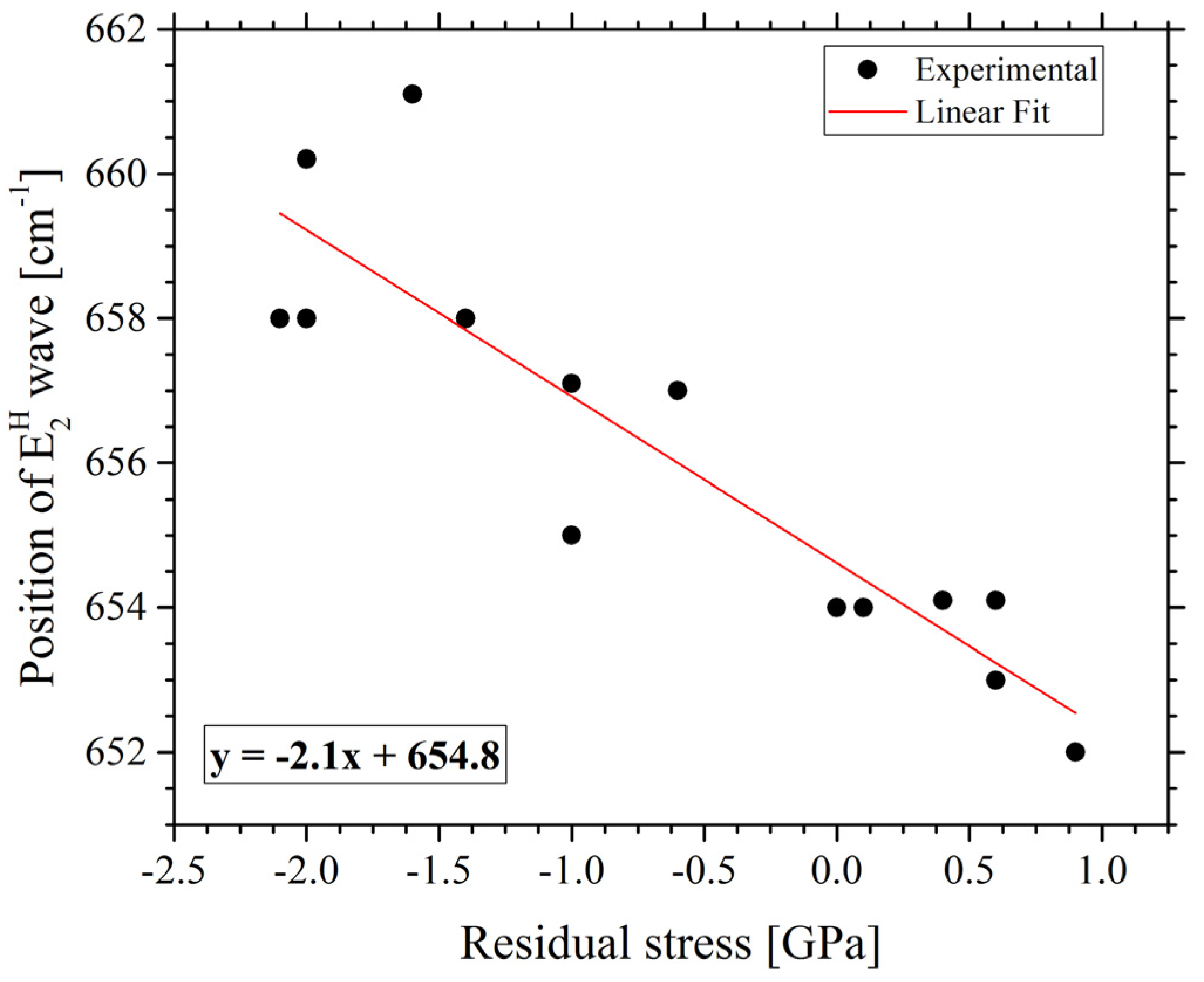
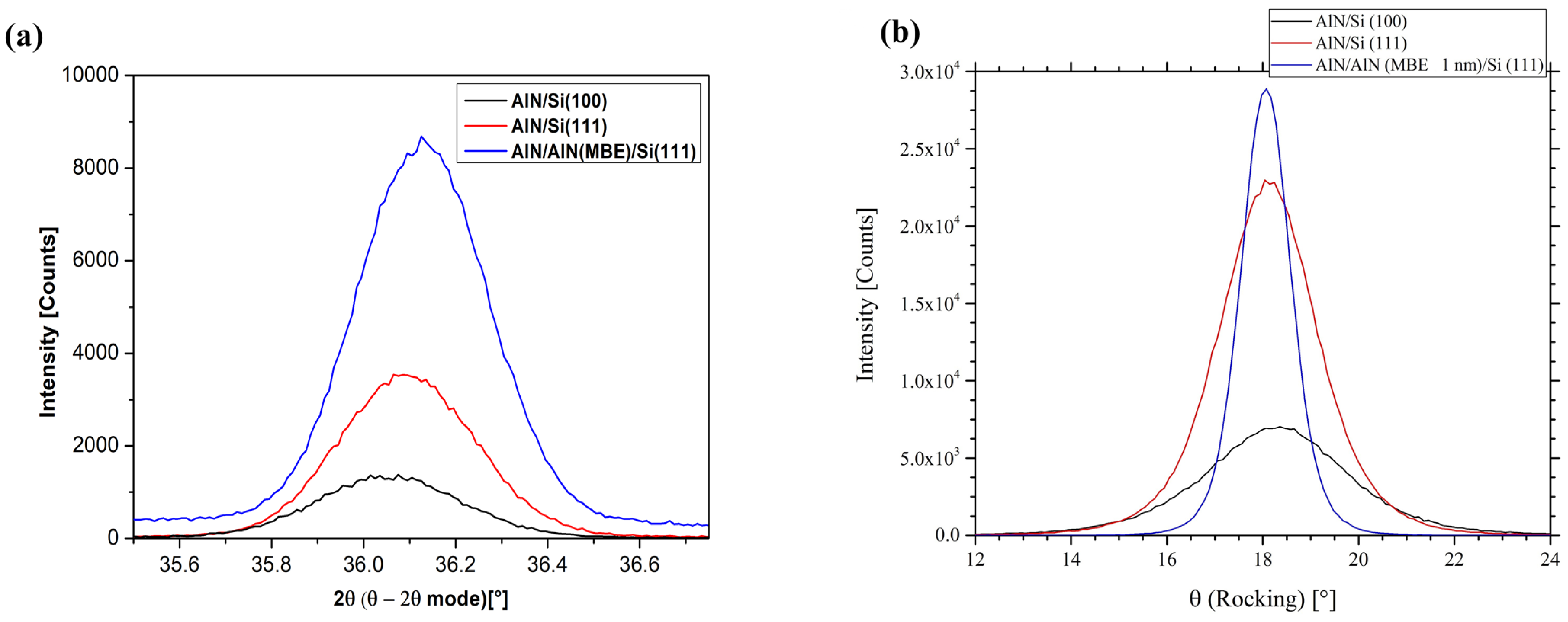
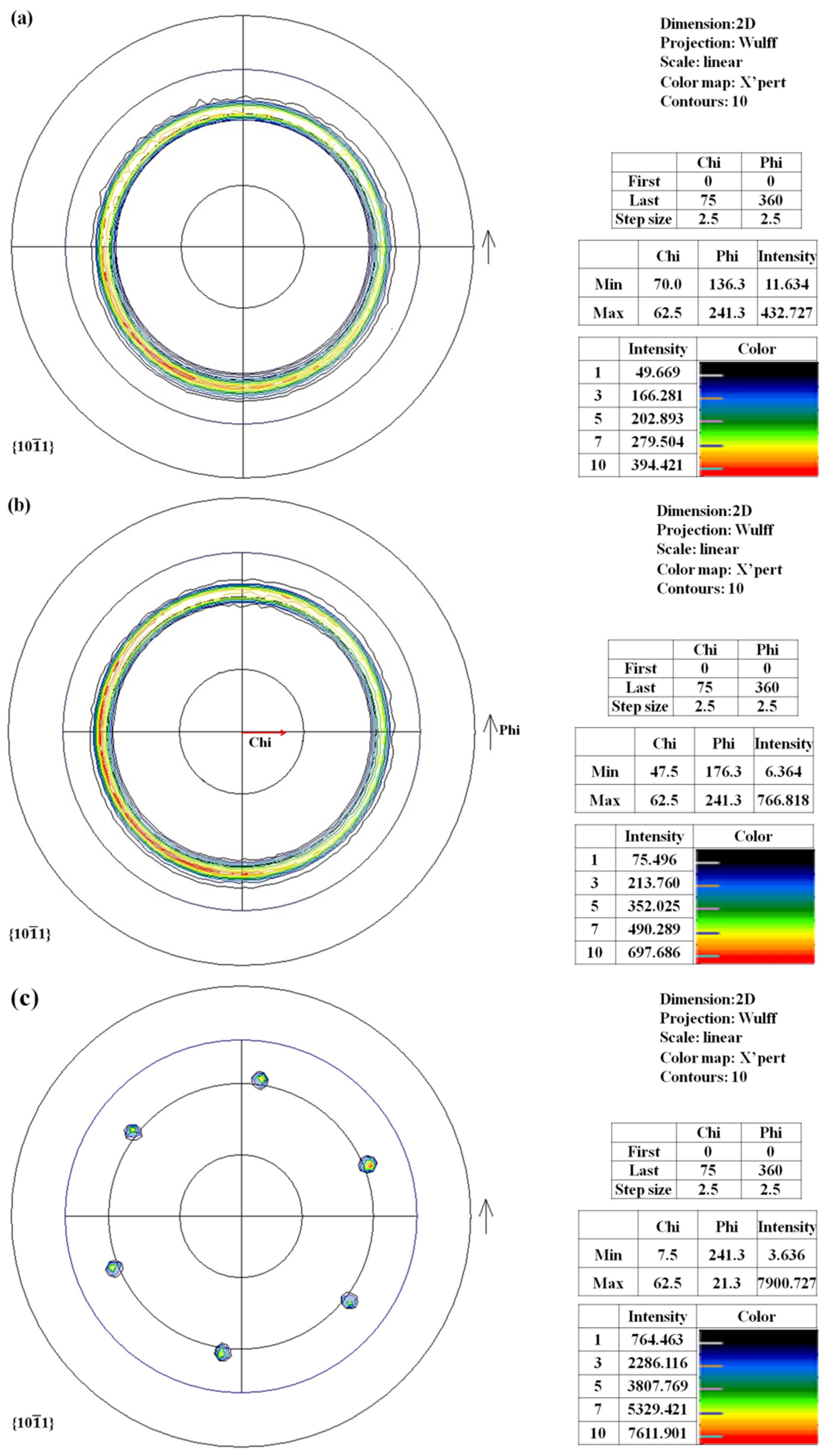
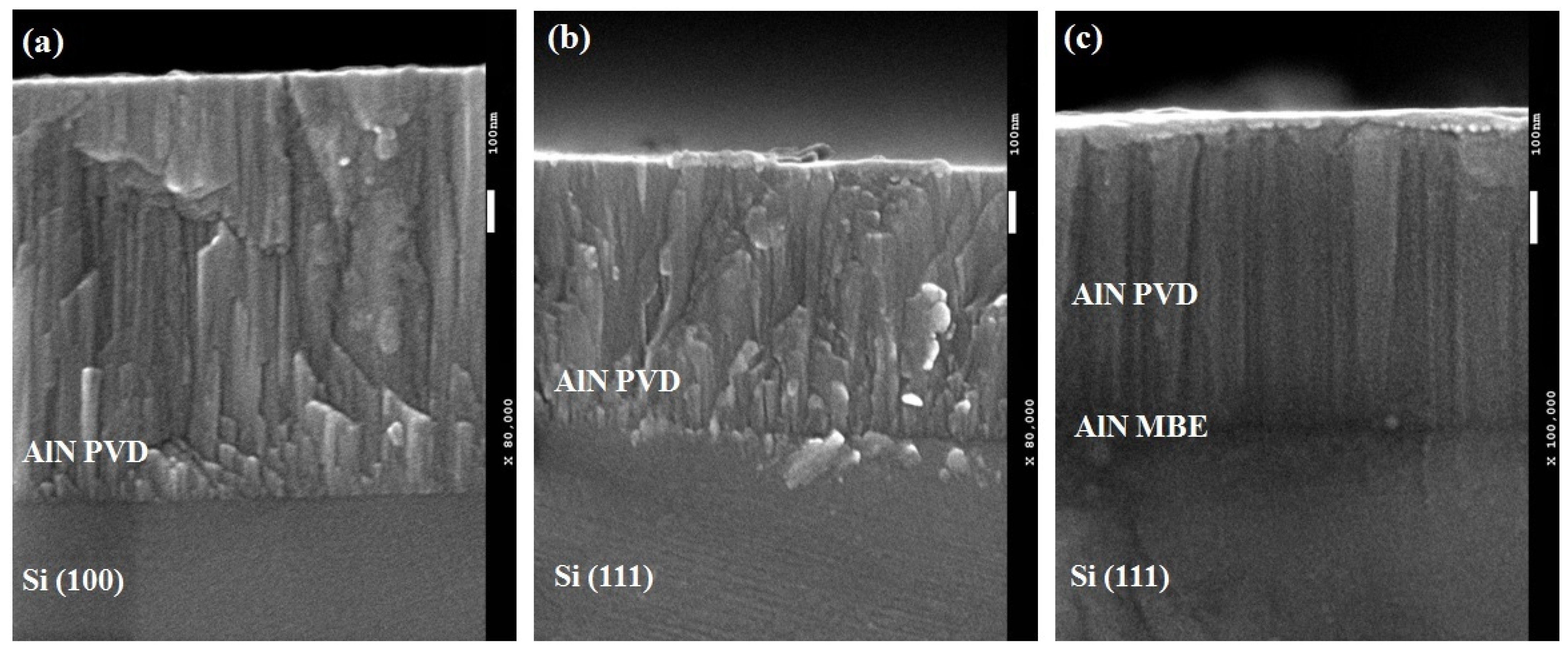

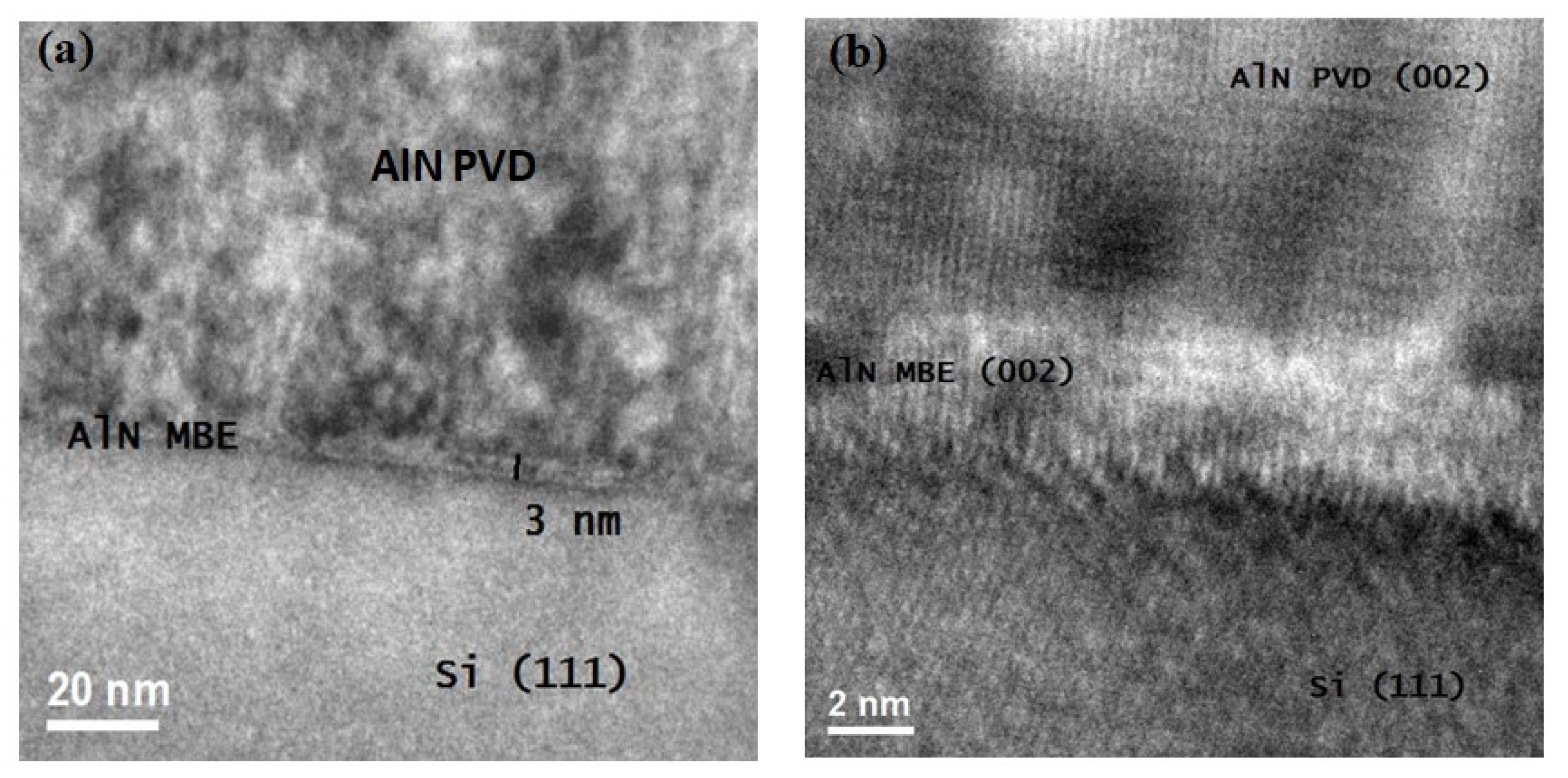
Publisher’s Note: MDPI stays neutral with regard to jurisdictional claims in published maps and institutional affiliations. |
© 2021 by the authors. Licensee MDPI, Basel, Switzerland. This article is an open access article distributed under the terms and conditions of the Creative Commons Attribution (CC BY) license (https://creativecommons.org/licenses/by/4.0/).
Share and Cite
Riah, B.; Camus, J.; Ayad, A.; Rammal, M.; Zernadji, R.; Rouag, N.; Djouadi, M.A. Hetero-Epitaxial Growth of AlN Deposited by DC Magnetron Sputtering on Si(111) Using a AlN Buffer Layer. Coatings 2021, 11, 1063. https://doi.org/10.3390/coatings11091063
Riah B, Camus J, Ayad A, Rammal M, Zernadji R, Rouag N, Djouadi MA. Hetero-Epitaxial Growth of AlN Deposited by DC Magnetron Sputtering on Si(111) Using a AlN Buffer Layer. Coatings. 2021; 11(9):1063. https://doi.org/10.3390/coatings11091063
Chicago/Turabian StyleRiah, Badis, Julien Camus, Abdelhak Ayad, Mohammad Rammal, Raouia Zernadji, Nadjet Rouag, and Mohamed Abdou Djouadi. 2021. "Hetero-Epitaxial Growth of AlN Deposited by DC Magnetron Sputtering on Si(111) Using a AlN Buffer Layer" Coatings 11, no. 9: 1063. https://doi.org/10.3390/coatings11091063




